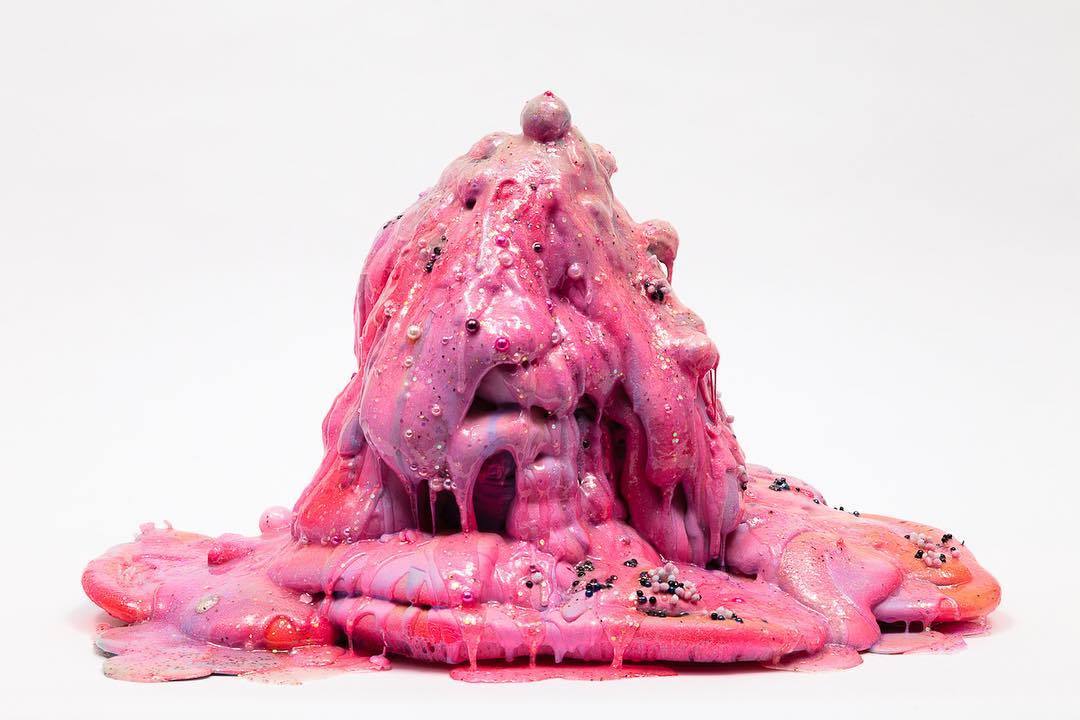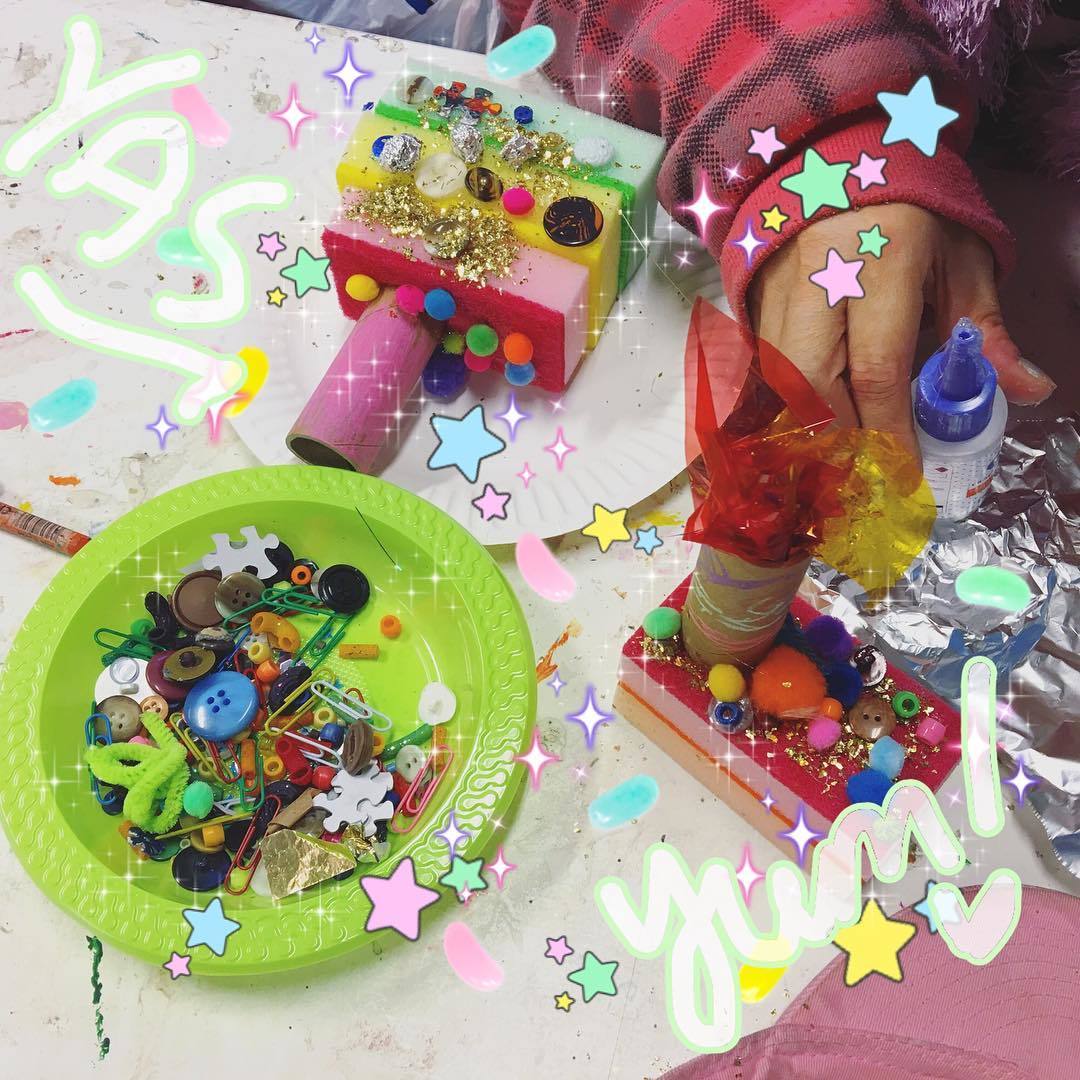Louise Zhang’s artwork looks like she put all of Harajuku in a microwave until it melted together. Her bright, kitschy work begs to be touched, but the allure is more than tactile. Amidst the drips and splotches lies a something more complex. Her pieces blend the grotesque and beautiful to comment on her place as an Asian-Australian, an artist and an individual. These fluorescent objects dotted cute emojis clearly delight a lot of people: she has a 22k strong Instagram following. We caught up with Louise to chat about self discovery through slime.
Your work feels magical — are you influenced more by the natural world or other artists?
John Wolseley is a huge influence for me; he’s an Australian artist who works with the land, he basically showed me you can do anything with art. He was really inventive, I realised through his work that you can do more than just frame your work and stick it on a wall. James Jean is another one, he made me see I can marry my Western upbringing with my Chinese heritage.
Tell me more about identity inspiring your work.
I think your interests speak about your identity and your identity feeds into your artwork. My interests lie in horror films, I love gore and all that dark stuff, but I also really love kitschy, over-the-top, cute, fluffy stuff. I’m trying to marry these two things together because they seem like opposites but to me they’re not. I find all that kitschy, plastic stuff to be a kind of faux happiness — it’s cosmetic and over the top and there’s actually a lot of darkness underneath all that.

What does your art say about your own identity? Does it feel very intimate?
Well, some artists’ whole drive is to explore their identity and to make it known. For me, it’s about my personal experience of living in Australian and growing up in an immigrant family. Right now that’s where my new body of work is going. I only recently discovered that I should be honouring my Chinese heritage rather than dishonouring it. When you’re growing up you just want to fit in and fitting in for me was denying my Chinese identity. But being surrounded by artists who are exploring their identity very explicitly has made me question why I haven’t been doing that, it’s clearly an important thing for me to work through if I feel the need to suppress it.

Let’s talk more about that plastic “faux happiness” you mentioned.
I feel like the world is flooded with fakery. I’ve been looking at a lot of Chinese New Year posters from the 70s and 80s and they’re basically to promote health, happiness and prosperity. But the impression given in these posters is of a happiness and unity that’s totally fake. In today’s society I think a lot of our interests are dictated for us, and it’s done using colour and things that look perfect and enticing which makes you want it even more.

Do you set out to overload the senses?
I use a lot of colours because I want to seduce people. I want to overstimulate people. A lot of the feedback and comments I get are about how much people love the colours and how pretty they and I’m like, yeah I’m just trying to suck you in! Hopefully after that initial impression, the viewer can meditate on it a little more.
Let’s talk about social media. You’re not necessarily an “internet artist,” but you’re an artist who’s big on the internet.
I started off using this thing called Devianart, I don’t know if you remember it, because I wanted to be an illustrator. I actually struggled with social anxiety and couldn’t leave my house, so the only way for me to actively share my work with the outside world was through social media platforms. Even once I got over that I still understood how important they are in society. It’s such a fast way of communicating; it’s kind of like this visual explosion. I’ve gotten so many opportunities and met so many people though social media, so I’d say it’s the most important form of communications nowadays.

We’ve talked a lot about your art — let’s talk about you online. What do you think entices people into this gooey, slimy world?
I think it’s a couple of things: the pages I follow are less polished, some pages on Instagram are so curated I find them really boring. I want to know what happens behind all that. There’s always a mystery around creating art, so to be able to reveal that and see how an artist actually works is really nice. Also, humans are just weird — there are all these pages dedicated to people poking their fingers in slime and stuff like that. There’s a visceral nature to something that’s slimy that people find seductive and attractive. That’s why I started working with these forms, I wanted to capture that in a gross and attractive way at the same time.
So what’s next?
I’m working on a solo show at the Gaffa Gallery as part of winning the Yen Female Art Awards last year. I love horror, but I want to reconnect with my Asian heritage, so I started looking at Chinese horror as a part of this project. It’s practically non-existent because of censorship, so I’m trying to marrying Western horror movies with Chinese propaganda posters. I wanted to question how you can censor horror films when the basis of that government is, in my opinion, so horrible.
Credits
Words Kasumi Borczyk
Images via Instagram
